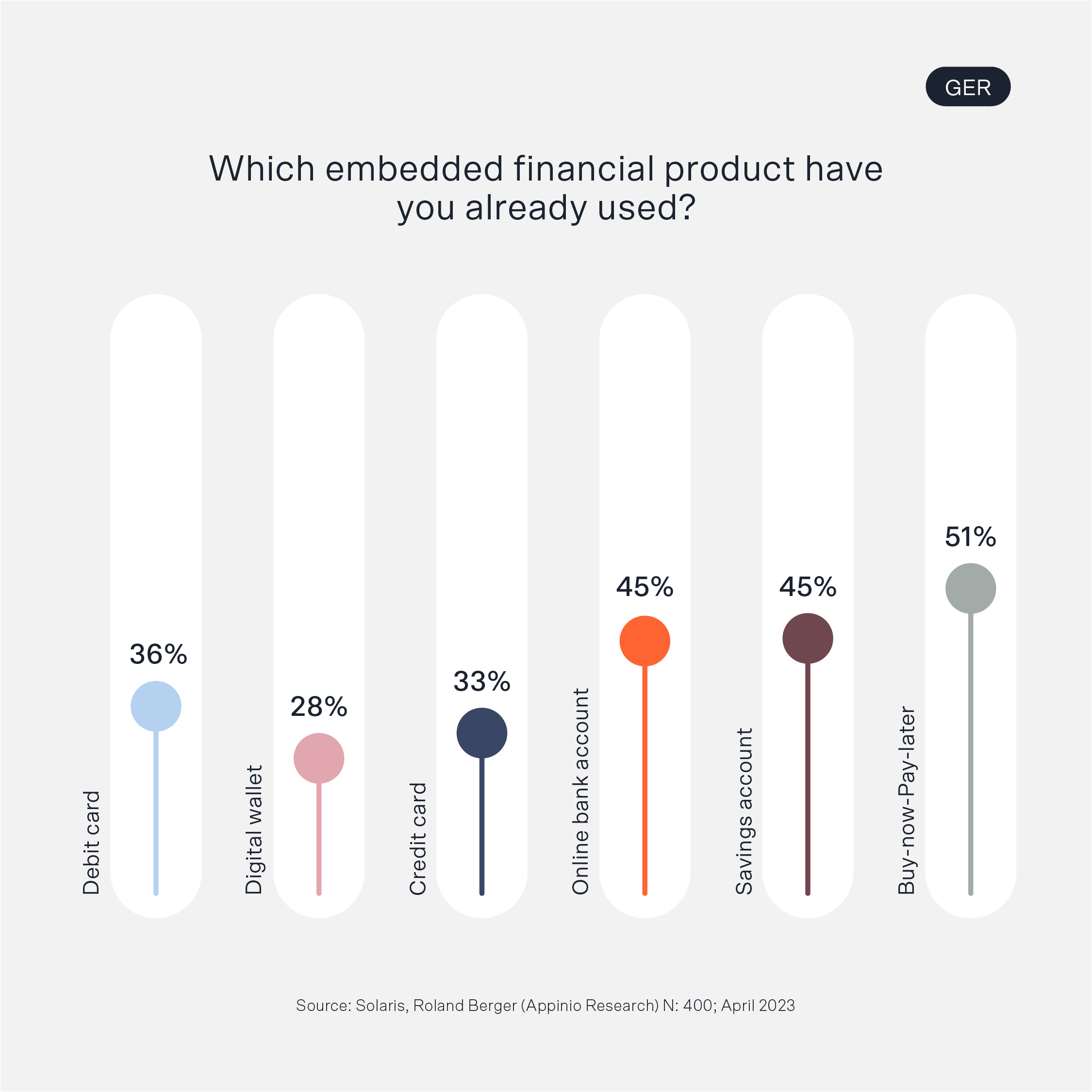How pizza sparked an embedded finance revolution
5 minute read


One thing that has driven innovation in the digital world is hunger.
Getting food quickly and easily is essential in today's world. It's not for nothing that "fast food" in all forms is a huge success.
Even the very first online purchase was triggered by hunger.
So, 2024 will mark the 30th anniversary of the day a man logged onto an electronic storefront called "PizzaNet" on PizzaHut.com and – according to the pizza brand – made the world's first online purchase: a large pizza with pepperoni, mushrooms and extra cheese.
It's quite surprising that it took another five years before it was possible to buy movie tickets via a cell phone in 1999. A digital payment solution introduced by Norwegian cell phone pioneer Ericsson.
But from then on, things moved faster and faster. And today it's hard to imagine our everyday lives without seamlessly integrated financial services.
Growing popularity of embedded finance among consumers
In our lives, some embedded financial services have become so commonplace that they are among the most widely used financial tools.
In a survey conducted in November 2021 for the popular "E-Commerce in Europe" study, 50% of German respondents said that PayPal (or similar payment options) is the most preferred method for paying for an online purchase.
A current analysis by Statista shows just how much mobile payments at the point of sale (POS) have become the norm in recent years.
It is estimated that the transaction value will reach EUR 507.60 billion in 2023. And is expected to have a compound annual growth rate (CAGR) of 17.40% from 2023-2027. This will lead to a total projected amount of EUR 943.80 billion by 2027.
However, the use of digital financial services does not stop at payment methods.
In all areas, embedded financial services are overtaking traditional offerings, as a study by the German industry association bitkom from 2022 shows.
Interestingly, this study points out that 41% of Germans already use only online banking and no longer frequent a bank branch.
The latest figures suggest that there will be even more "online-only banking" in the future.
When asked where processes in banking matters are handled best, most German respondents choose online banking as the answer. In a Statista online survey in 2023, 56% of respondents answered this way.
Success formula: Enhanced convenience, seamless integration and trust
Of course, digitization will continue and user behavior will continue to adapt.
But, financial services need some more factors to resonate with customers in the long run, than e-commerce or software products.
At the top of the list for customers is certainly trust in the respective provider – even if the brand of choice only operates the app or website for its core products and works with a banking-as-a-service provider in the back.
In a 2022 survey conducted by Solaris together with the renowned Handelsblatt Research Institute on the use of embedded financial services in the mobility industry, the main result was the following:
The higher respondents rated the safety and reliability of a mobility brand, the greater their willingness to use a financial product from that brand. In all four markets surveyed (Germany, France, Italy, Spain), the acceptance rate was always well above 30%.
This year, Solaris conducted a survey on consumer behavior with regard to embedded financial services in the four largest markets of the European Union together with the management consultancy Roland Berger.
41% of participants named easier access to financial services in comparison to traditional banks as the main reason for using embedded financial services.

This response highlights the fact that accessibility of financial products is now commonplace in the digital world.
The overall average figure from all the markets surveyed clearly shows that applications and handling in bank branches is on the decline throughout Europe. This will continue to increase in the coming years.
39% of respondents said the good availability of embedded financial solutions at the checkout was one of the main reasons for using built-in financial services. Certainly, buy-now-pay-later (BNPL) and digital payment methods are now standard e-commerce applications that have been internalized and are popular with customers.
But above all, checkout must be convenient and fast.
32% of respondents point to an improved user experience as the reason for using embedded financial products.
This is likely to be a relevant factor not only for the B2C sector, but also plays a major role in the B2B market.
For example, Finom – a one-stop-shop platform for banking, invoicing and expense management for entrepreneurs and SMEs – is entirely focused on developing the best UX for its business customers. In doing so, the company is very successful and combines financial services from different providers on its platform, from bank accounts to tax calculation.
On the way to a cashless age
The rise of cashless and cardless payment methods was prevalent among the types of embedded financial services currently used by consumers.
Debit cards are now used by a high proportion of people everywhere in Europe. With a usage rate of 39%, they are the preferred financial tool in our survey.
Surprisingly, the use of digital wallets comes in second place at European level. A high proportion of 36% of respondents said they use a digital wallet. This puts its use ahead of that of credit cards (34%) and online bank accounts (28%).
Another sign that the trend toward cashless payments is unbroken since 2019.
For 2025, it is predicted that a customer will spend EUR 4740 per year on cashless payments. This is 50.48% more than the EUR 3150 spent by consumers in 2022 through cashless payments at the POS.
Respondents' reactions to the use of BNPL offerings varied quite a bit across the markets we surveyed.
While BNPL was mentioned by 18% of respondents across Europe, it is by far the most popular embedded financial service solution in Germany, recognized by 51% of respondents.
This is consistent with the findings of a recent study by Research and Markets, which indicates that Germany is one of the most important markets for BNPL in Europe.
The authors of the study estimate that BNPL transactions in Germany will be almost 20% higher in 2023 than in 2022.

When asked about the use of embedded financial solutions in e-commerce, a whopping 58.9% of German respondents answered that they had used BNPL at least once.
This is evidence that partnerships with fintechs can help e-commerce skyrocket growth. Cart abandonment and churn rates can be reduced with integrated BNPL.
Customers focus on saving and safety
It should not have escaped anyone's notice that interest rates for savers have been returning since the beginning of 2023.
Savings accounts are therefore high on the list of planned uses for digital bank accounts. On average, 26% of respondents want to use a digital savings account in the future.
It is not only the Germans, who are known for their thriftiness, who want to use a savings account; in France, most users (30%) are willing to deposit their money for a longer period of time.
A result that surprised us: Insurance is high up in our rankings. On average, 25% of respondents plan to take out new insurance policies in various areas.
Of course, with the rise of digital insurers, buying insurance has naturally become much more convenient for customers.

Today, it's easier than ever to get the best possible insurance coverage on the best terms. As the example of Clark shows, which has risen to unicorn status in a very short time with its alternate model.
If the respondents' statements are interpreted as a willingness to switch to digital insurance offerings, insurers should be very attentive.
And partnerships with fintechs will create new opportunities for insurers. Above all, greater transparency and customer friendliness will cause upheaval in the coming years.
But, most respondents are firmly committed to using a digital wallet in the near future. At 29%, this is an absolute winner in the area of embedded finance.
All of this suggests that banking, payments, loans, BNPL, and insurance will be conveniently bundled on any smartphone in the future.
Digital finance was yesterday, mobile finance is today.

